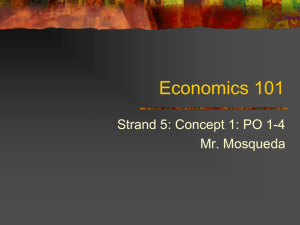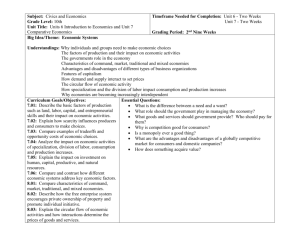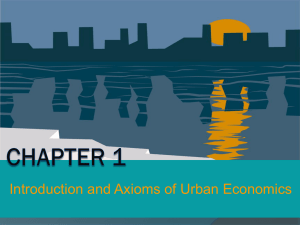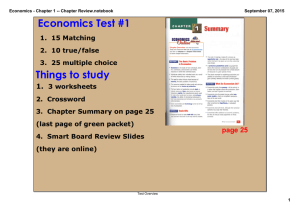Economics
advertisement
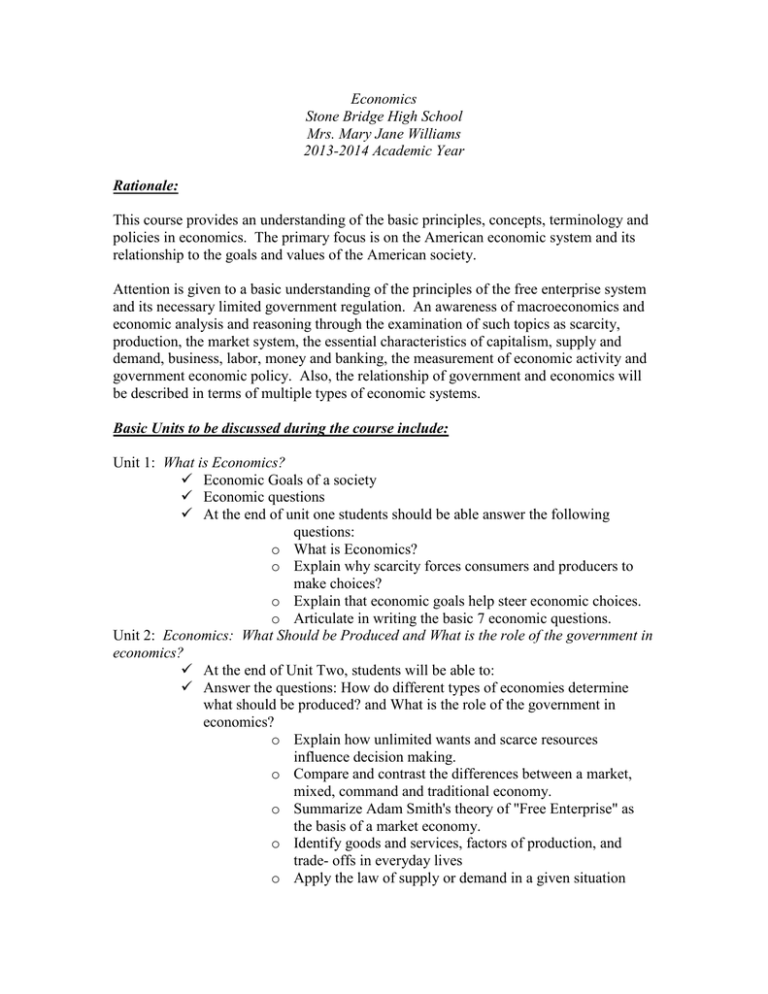
Economics Stone Bridge High School Mrs. Mary Jane Williams 2013-2014 Academic Year Rationale: This course provides an understanding of the basic principles, concepts, terminology and policies in economics. The primary focus is on the American economic system and its relationship to the goals and values of the American society. Attention is given to a basic understanding of the principles of the free enterprise system and its necessary limited government regulation. An awareness of macroeconomics and economic analysis and reasoning through the examination of such topics as scarcity, production, the market system, the essential characteristics of capitalism, supply and demand, business, labor, money and banking, the measurement of economic activity and government economic policy. Also, the relationship of government and economics will be described in terms of multiple types of economic systems. Basic Units to be discussed during the course include: Unit 1: What is Economics? Economic Goals of a society Economic questions At the end of unit one students should be able answer the following questions: o What is Economics? o Explain why scarcity forces consumers and producers to make choices? o Explain that economic goals help steer economic choices. o Articulate in writing the basic 7 economic questions. Unit 2: Economics: What Should be Produced and What is the role of the government in economics? At the end of Unit Two, students will be able to: Answer the questions: How do different types of economies determine what should be produced? and What is the role of the government in economics? o Explain how unlimited wants and scarce resources influence decision making. o Compare and contrast the differences between a market, mixed, command and traditional economy. o Summarize Adam Smith's theory of "Free Enterprise" as the basis of a market economy. o Identify goods and services, factors of production, and trade- offs in everyday lives o Apply the law of supply or demand in a given situation o Make the connection between competition, price and profit in a market/mixed economy o Defend the notion that "monopolies destroy free market competition" o Illustrate the circular flow of economic activity o Compare the role of government in the decision of what to produce in market, mixed, command and traditional economies. o Determine which US economic goals could be affected by the economic factors and principles studied in this unit. Unit 3: Economics – Who should produce the goods? Who should receive the output of production? Who should receive government assistance? At the end of the unit, students will be able to: o Discuss how market, mixed, command and traditional economies decide the following "Who" questions (who should do the producing in an economy? Who should receive the output of that production? Who should receive government assistance to meet their economic needs? o Apply Adam Smith's theory of "Free Enterprise" to the "who" questions for market/mixed economies. o Differentiate between different business models in the market and mixed economies: Sole Proprietorship; Partnership; Corporation; Franchise; Cooperative o Compare/contrast the roles of a business owner with an entrepreneur in a market or mixed economy. o Make a distinction between the role of government in market, mixed, command and traditional economies o Determine which US economic goals could be affected by the economic factors and principles studied in this unit Unit 4: Economics – How should growth be handled and How should growth be measured? At the end of the unit, students will be able to: o Answer the following questions: How is economic growth handled in different types of economies? and How is economic growth measured in different types of economies? o Explain what is meant by economic stability. o Demonstrate an understanding of the stabilizing tools used by the Federal Reserve in its monetary policy in the US o Describe how the Federal Reserve serves as the bank of the banks in the United States. o Analyze the role of financial markets in market and mixed economies. o Demonstrate an understanding of the stabilizing tools used by the Federal government in its fiscal policy in the United States. o Construct a diagram of the business cycle in the US and evaluate its stabilizing effects on the US economy o Give several examples of the economic interdependence in today's global community and explain how specialization leads to comparative or absolute advantage o Evaluate the effectiveness of today's global trade agreements and trade organizations o Formulate potential solutions to the problem of trade deficits and surpluses that lead to trade barriers such as protectionism and tariffs. o Analyze a country's economic situation by applying economic indicators such as GDP, CPI, the unemployment rate and the rate of inflation o Determine which US economic goals could be affected by the economic factors and principles studied in this unit. Textbook and Materials: Economics Alive Videos utilizing MJM Foodie videos and ACDC Leadership videos found on YouTube Student Responsibilities: 1. Be Prepared for Class - this implies that you should have your writing utensil for the taking of notes or doing class work, any homework assignments that are due that day and a notebook for worksheets and notes. 2. Please be on TIME --- I dislike being interrupted several times during a class period. Read your student handbook for the consequences for being late to class and/or school. 3. Limit your talking to the appropriate times. 4. Absences - any work missed due to an absence is your responsibility to make up. If an assignment was due the day you missed, then it is due upon your return. If a homework assignment was given out, then you will have the same time frame as your classmates to finish the assignment. 5. Tests and/or Quizzes - expect tests and quizzes in this class, but be forewarned if you miss a test or quiz, then the make up will NOT be identical, but more difficult. You have ONE week to make up a missed quiz and TWO weeks to make up a missed test. See Mrs. Williams for a pass if you wish to make up work during your study hall period. 6. In class work – a great deal of the "learning" will be taking place inside of the classroom, thus students should be prepared to work in the room. The work could include taking notes from the textbook, taking teacher generated notes, working on practice problems dealing with the economic concepts being presented in class and/or starting their homework assignments. Grading in this course 1. Tests – student should expect at least two unit tests which will cover three to four chapters each. The tests will include multiple choice questions, matching questions and free response questions in which students will be asked to analyze information and draw graphs for the answers. Tests will count 200 points in the grade book. 2. Quizzes – students will be given vocabulary quizzes during the course of the semester. They will be given a list of words to define and study. 3. Long term projects – students will be asked to complete a long term project for each of the two quarters – it may include creating and maintaining a budget, researching a country's and its economic status, or various other economic projects. Students will be given ample to time to complete the projects. Projects will count as 200 points in the grade book. 4. Notebook – students are required to maintain a notebook. At the end of the quarter, they will be given a notebook quiz utilizing the materials in their notebook. Thus, it is essential that absent students ask the teacher for any missed worksheets and find a "partner" in the class to copy the notes from.

